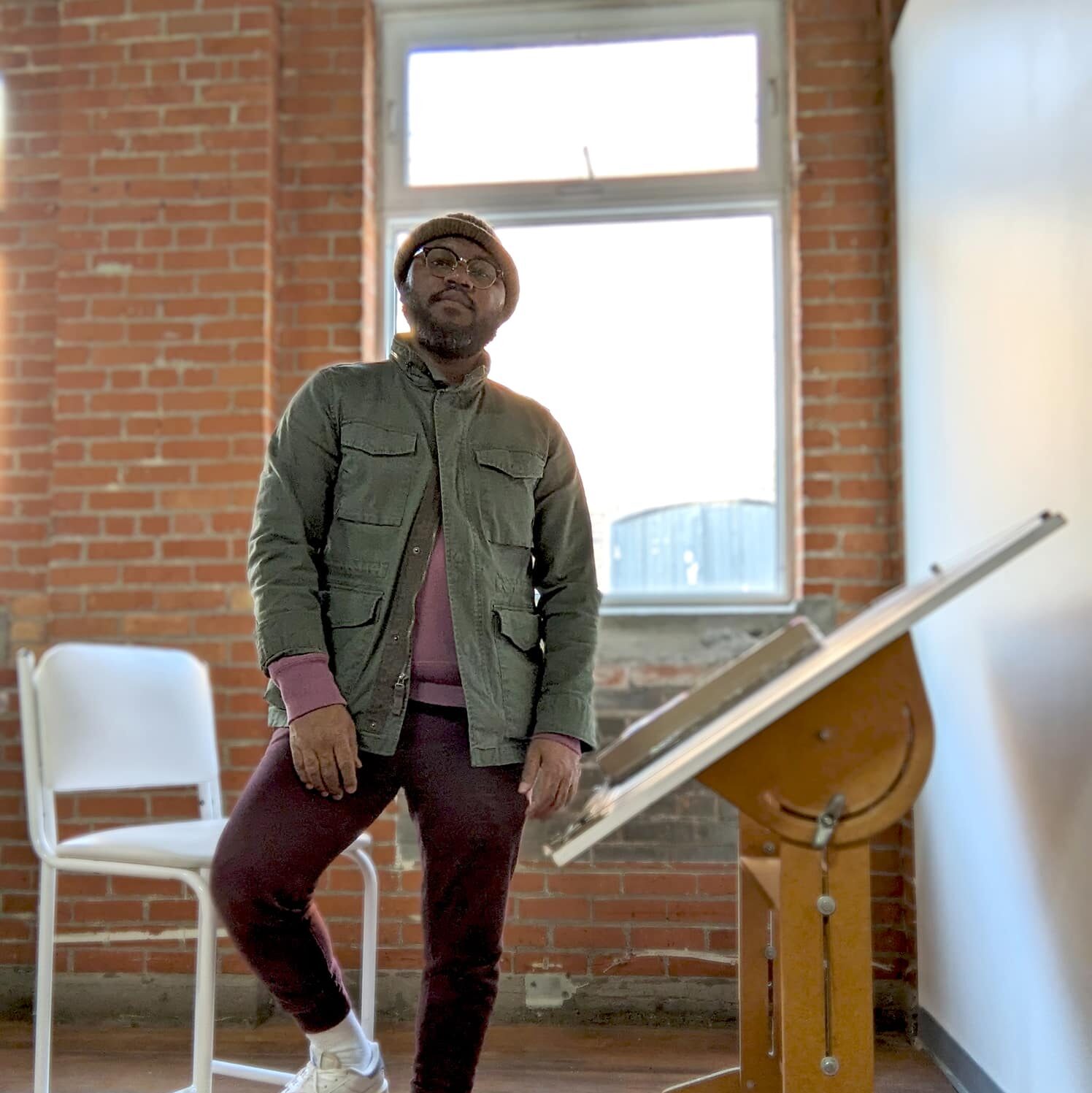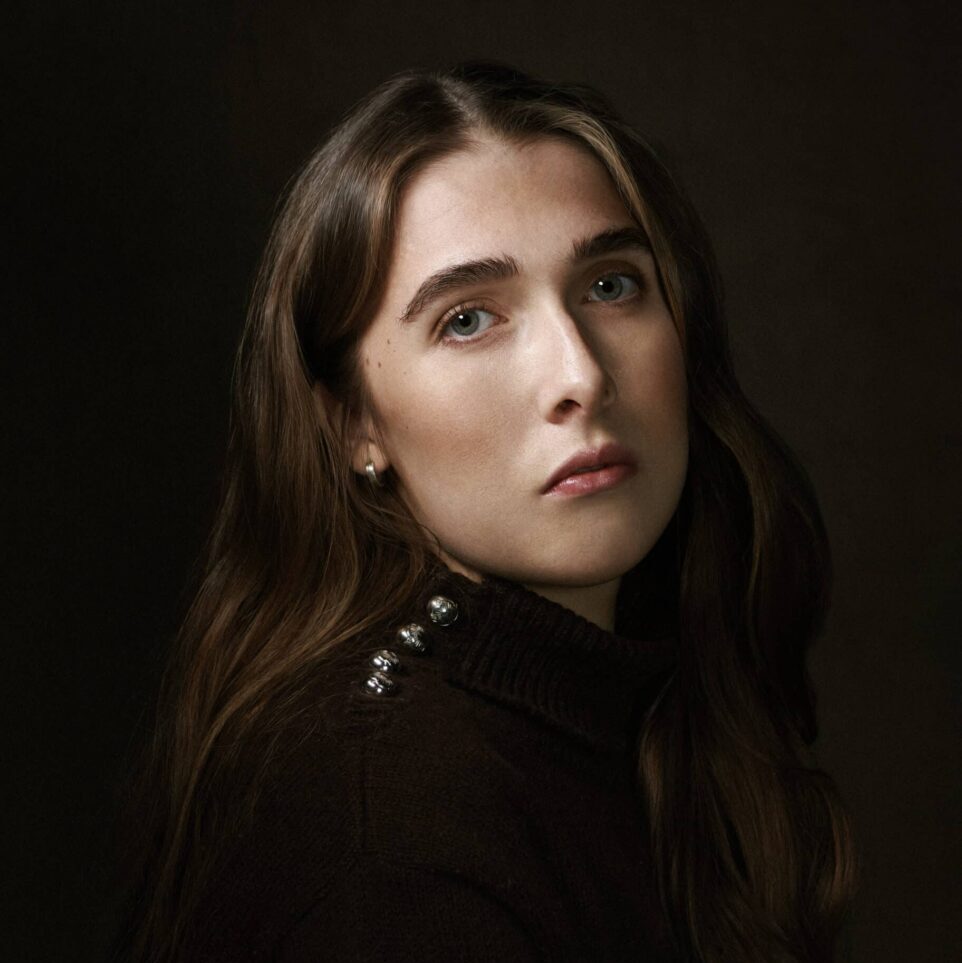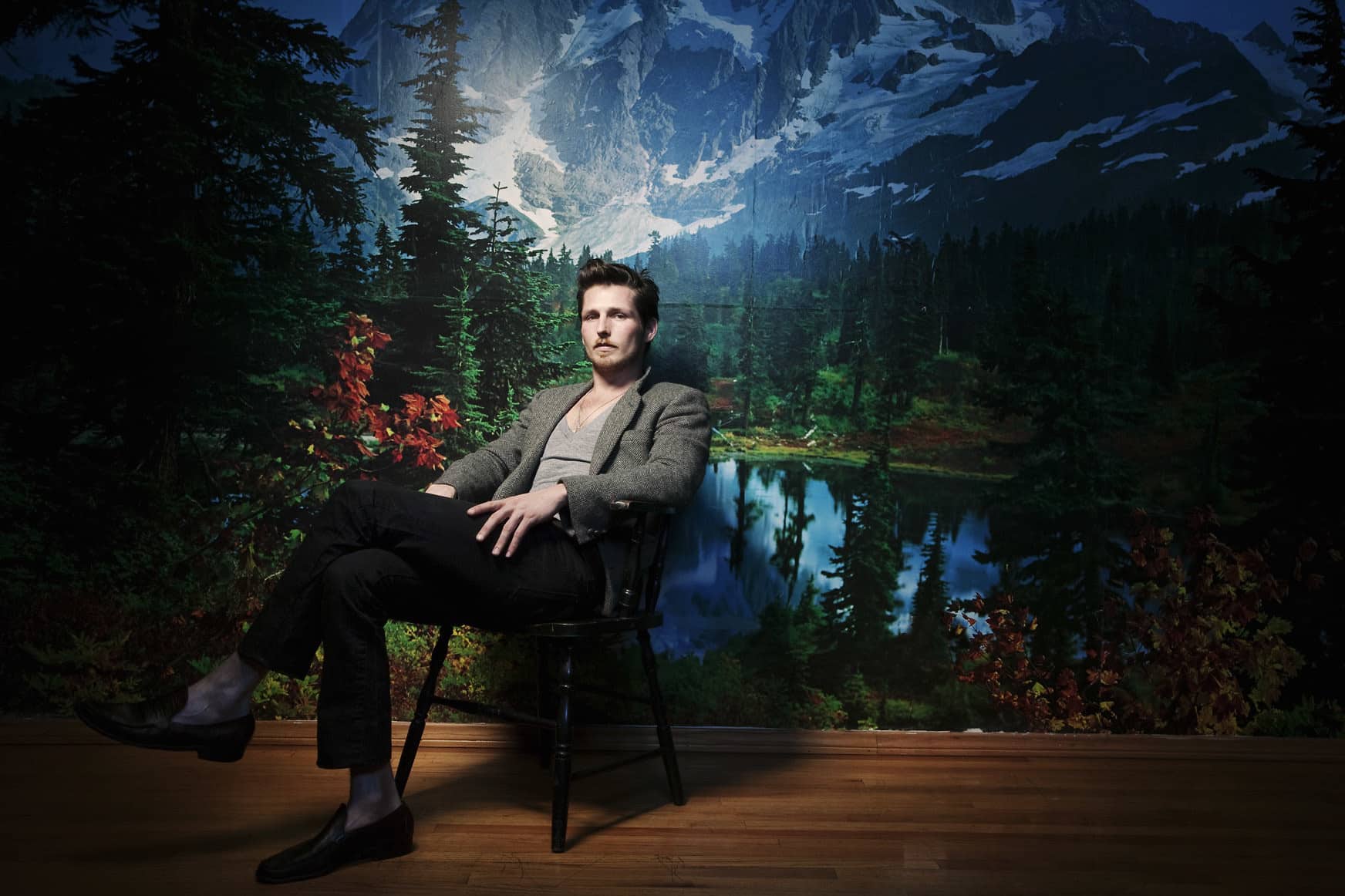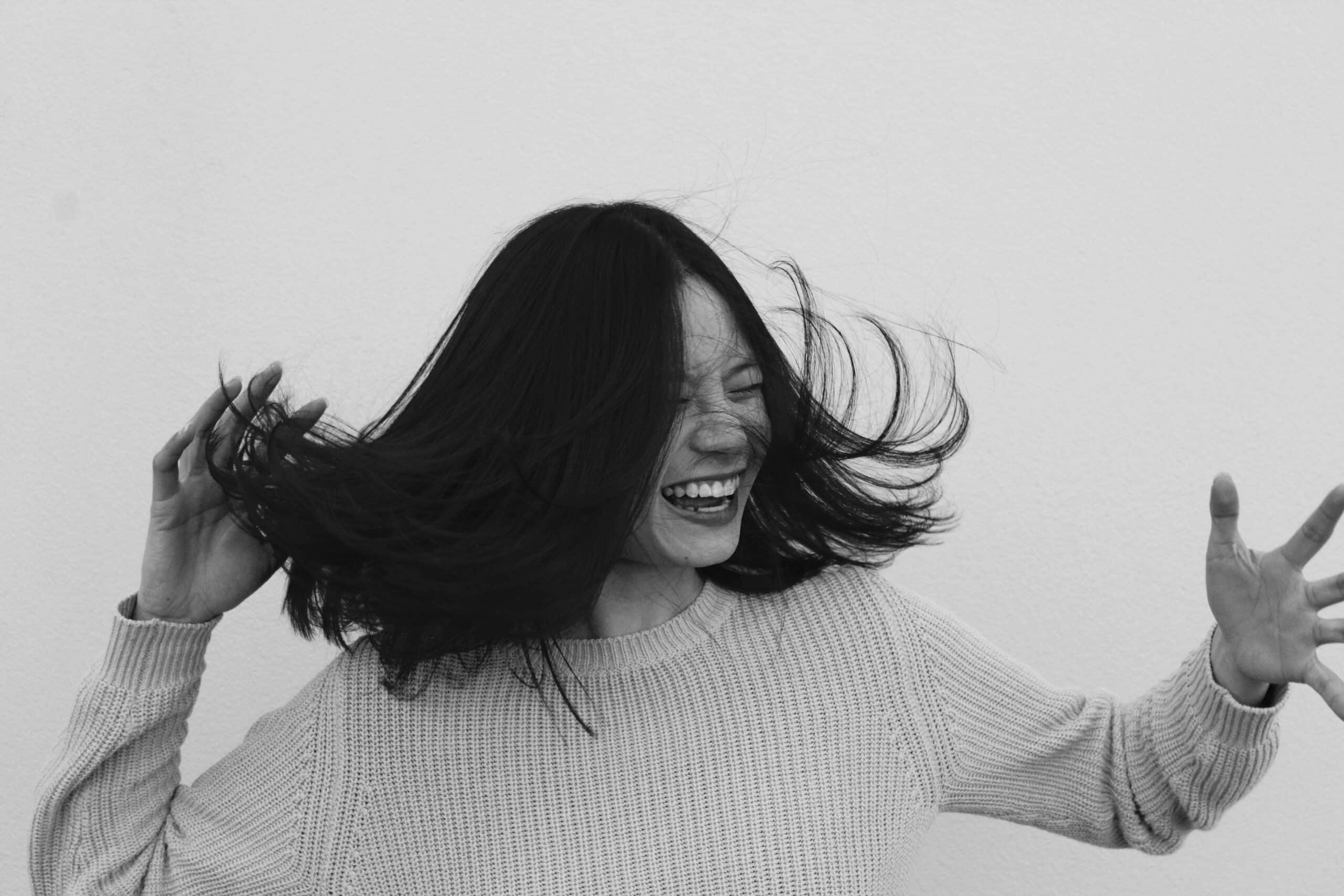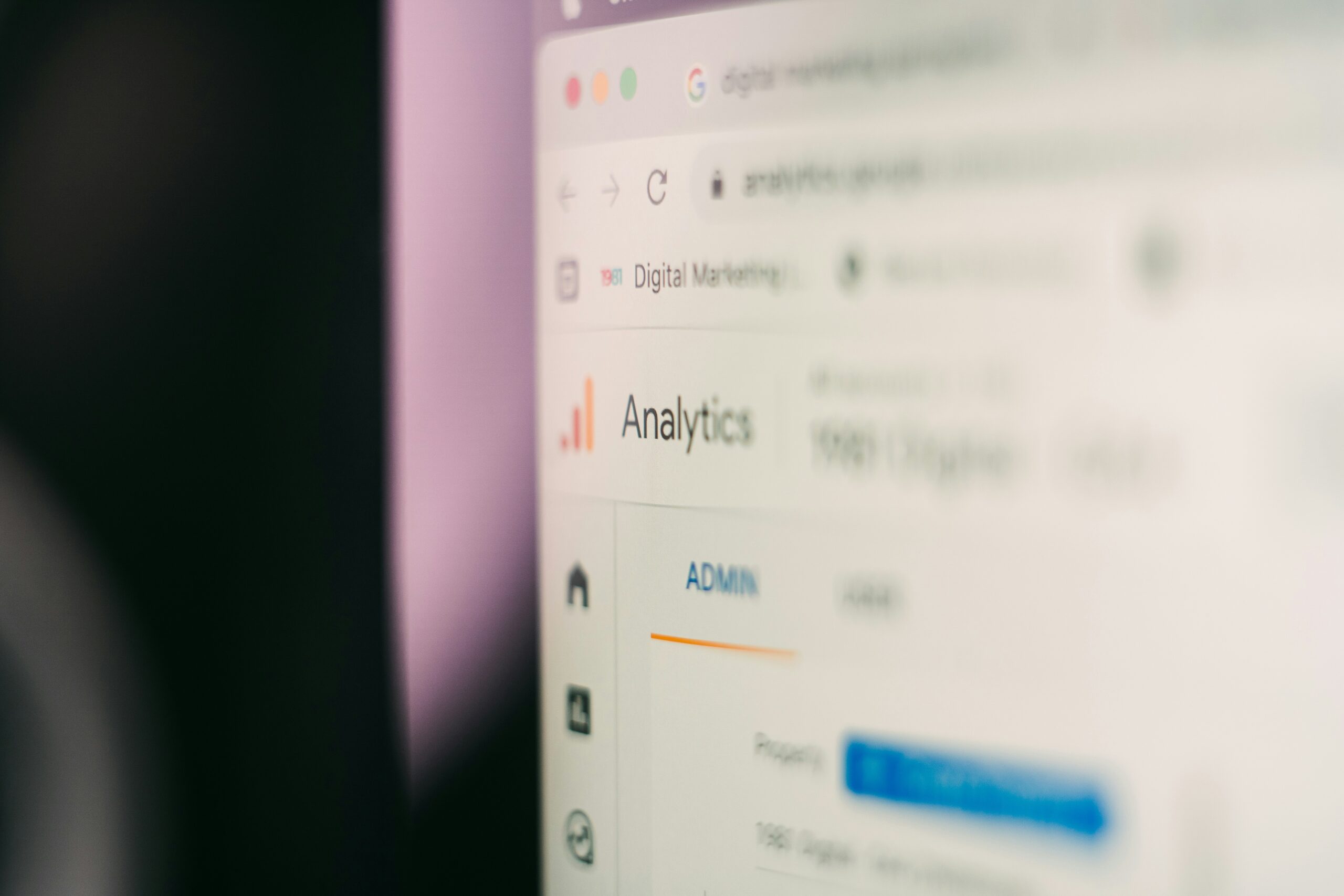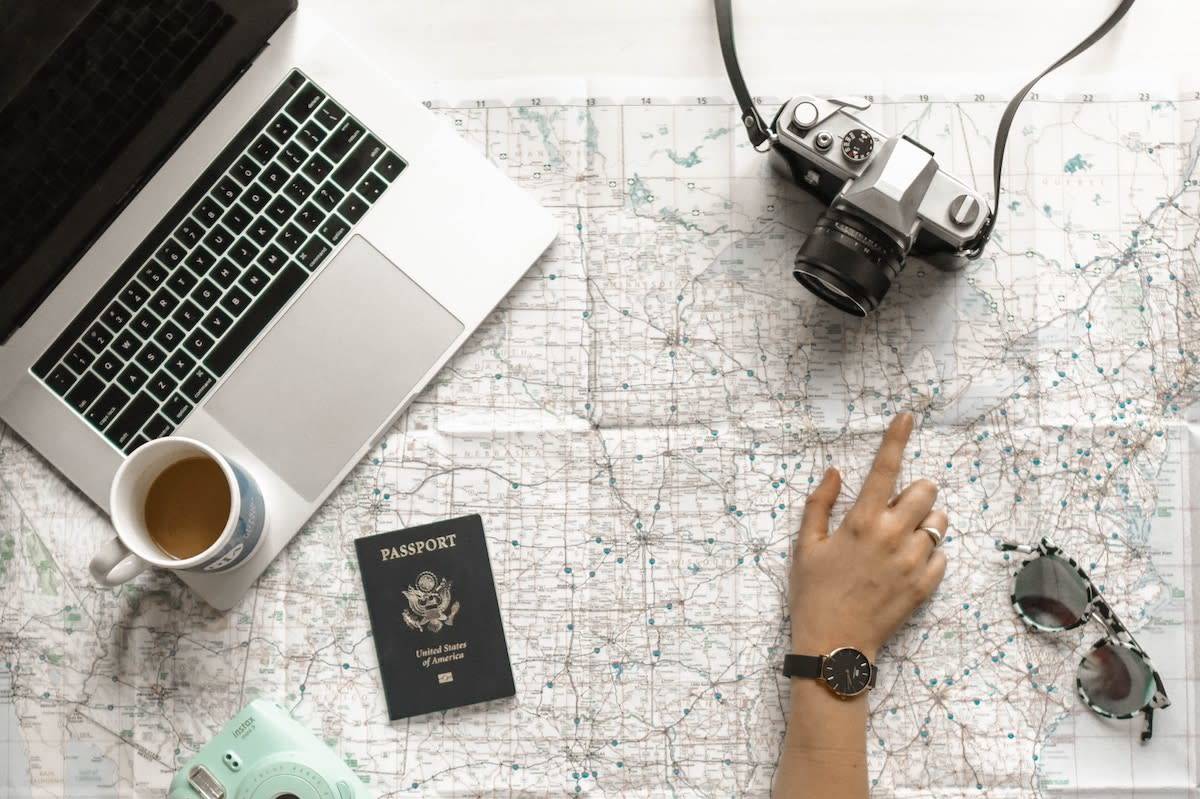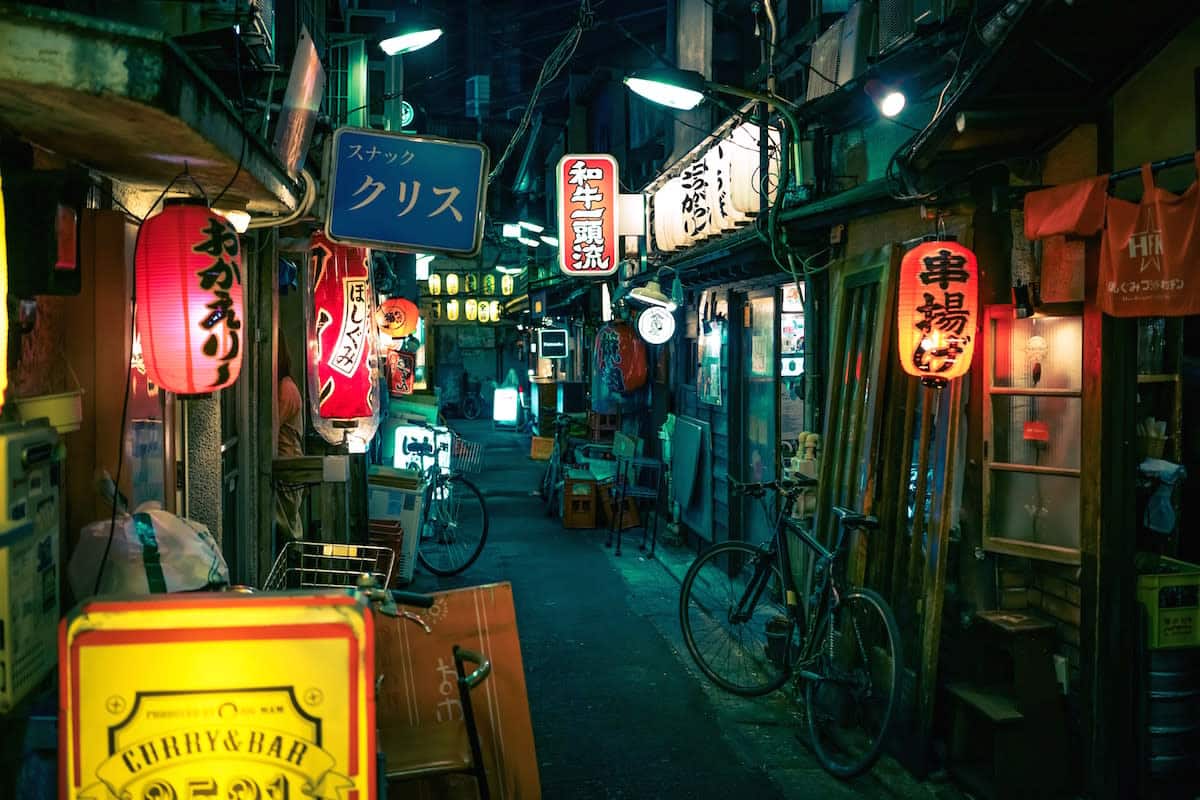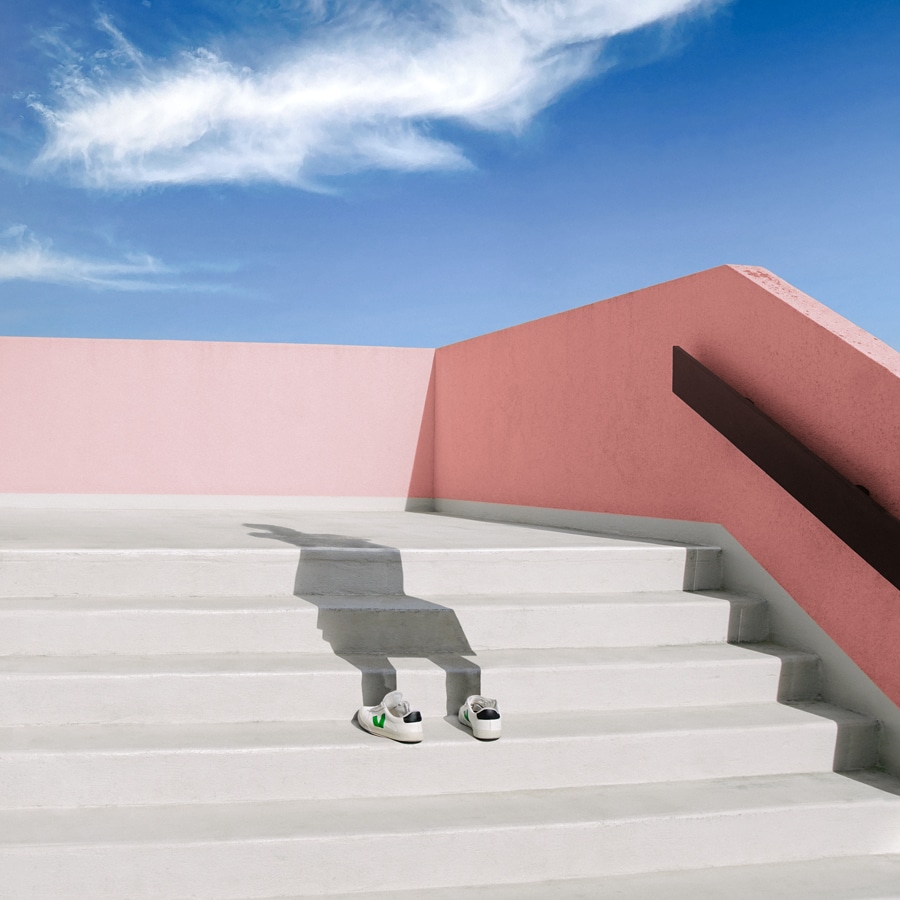Abraham s'est entretenu avec Format pendant la production d'une installation commandée par la Biennale d'art de Toronto et présentée conjointement avec la Gallery TPW. Le vernissage aura lieu le samedi 21 septembre 2024. Pour plus d'informations, consultez le site web de la Biennale de Toronto.
Pour voir d'autres travaux d'Abraham, Consultez son portfolio Format.
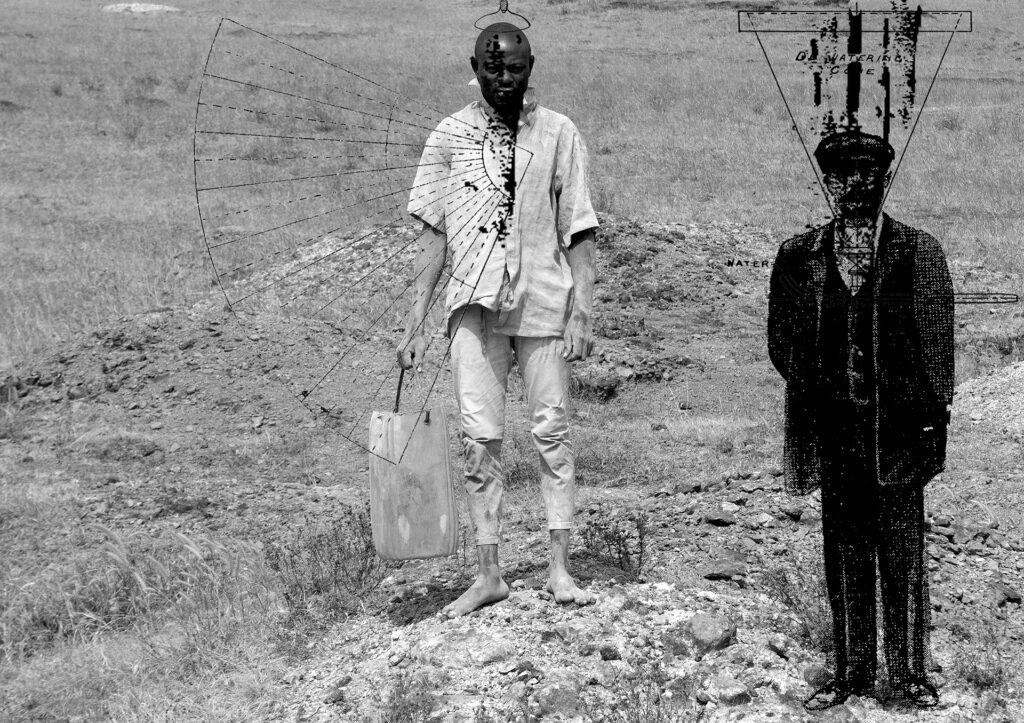
L'art est une vocation
Je m'appelle Abraham Onoriode Oghobase. Le nom Onoriode vient de la tribu des Urhobos, de l'État du Delta au Nigeria. Ce nom signifie "qui sait demain". Je suis né au Nigeria en 1979, à l'époque du boom pétrolier. Je suis donc né à cette époque où il y avait beaucoup, beaucoup d'argent au Nigeria. Mais en même temps, nous étions confrontés au régime militaire. Le régime a fait des allers-retours dans les années 80 et 90, avant que nous ne devenions une démocratie, avec un président démocratiquement élu.
J'ai grandi dans un environnement peu exposé à l'art. Il s'agissait vraiment d'être convenable, d'aller à l'école. Nous étions tous destinés à devenir ingénieurs ou comptables. Il n'y avait pas beaucoup de musées ou d'institutions artistiques à visiter pour les enfants. Je pense que nous nous contentions de jouer à l'église. Mais en grandissant, j'ai réalisé que j'aimais la musique, j'aimais les arts. Naturellement, je n'étais pas enclin à devenir un artiste étant donné l'environnement dans lequel j'ai grandi. Si je dis cela, c'est parce que je crois fermement que l'art est une vocation. Il vous appelle. Il ne suffit pas de savoir dessiner, de savoir peindre ou de savoir chanter. Je pense que c'est bien plus que cela. Il y a quelque chose de surnaturel qui l'anime.
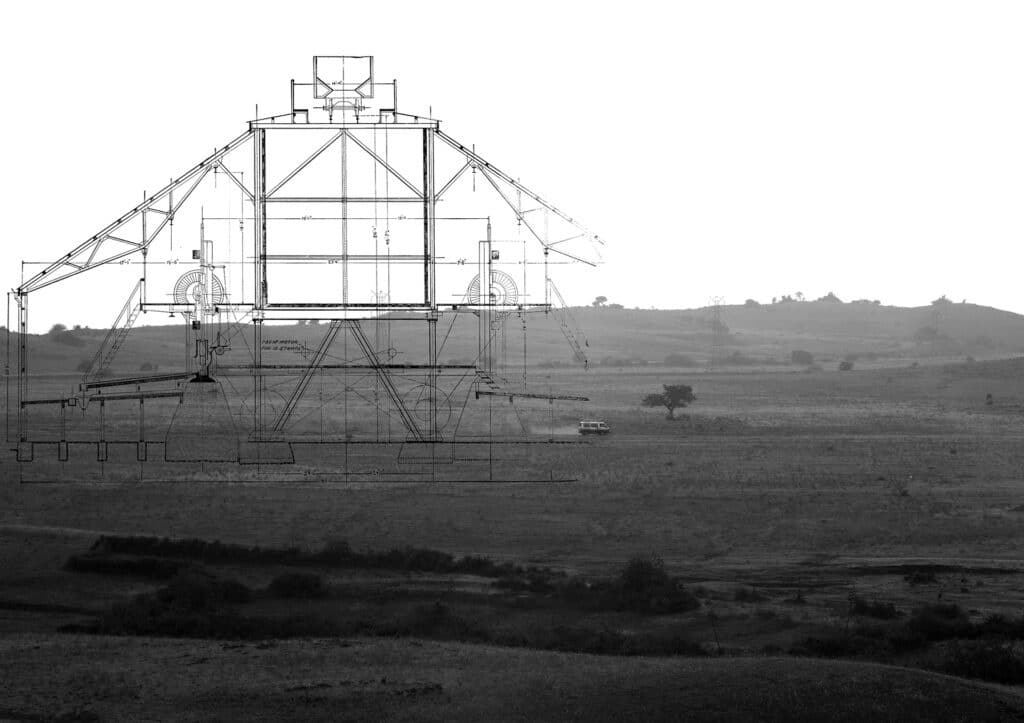
Abstractions, identité et post-colonialisme
Ma pratique porte essentiellement sur le post-colonialisme. J'explore l'identité et la représentation.
J'utilise les abstractions comme moyen d'engagement. Je m'intéresse beaucoup au langage et à la philosophie de l'esthétique. Qu'est-ce que cela signifie ? En apprenant, je me suis approprié certains langages à l'intérieur des structures des livres. Cela m'a amené à m'intéresser à la production de connaissances. À la base, cet intérêt pour la production est pour moi le résultat d'une prise de conscience des préjugés raciaux qui m'entourent. J'ai grandi au Nigeria, mais en grandissant, j'ai commencé à voyager. Et pour la première fois, j'ai pu faire la différence - OK, ma couleur noire était une chose. Dès que j'ai quitté ma communauté, c'est devenu une chose. Lorsque je suis arrivé en Europe et en Amérique du Nord, j'étais vraiment perdu. Je me suis rendu compte qu'il [le fossé racial] était très profond. Et bien que je sois noire, je viens d'une culture différente où ma noirceur n'était pas une telle différence. Je viens également d'une histoire différente de la production.
Et je pense que c'est ainsi que s'est amorcé le changement dans mon travail. En effet, ma pratique était principalement basée sur l'esthétique du format documentaire. Lorsque j'ai commencé à voyager en Europe vers 2006, c'est là que cette prise de conscience a commencé. Cela m'a amené à remettre beaucoup de choses en question : mon travail, ma pratique. Et puis la photographie est devenue vraiment ennuyeuse à un moment donné, j'ai pensé que la photographie n'était pas suffisante. Elle était trop bidimensionnelle, trop plate, pour capturer toutes les couches d'informations, d'émotions et d'identités dont je faisais l'expérience. La simple capture d'une représentation ne suffisait pas.
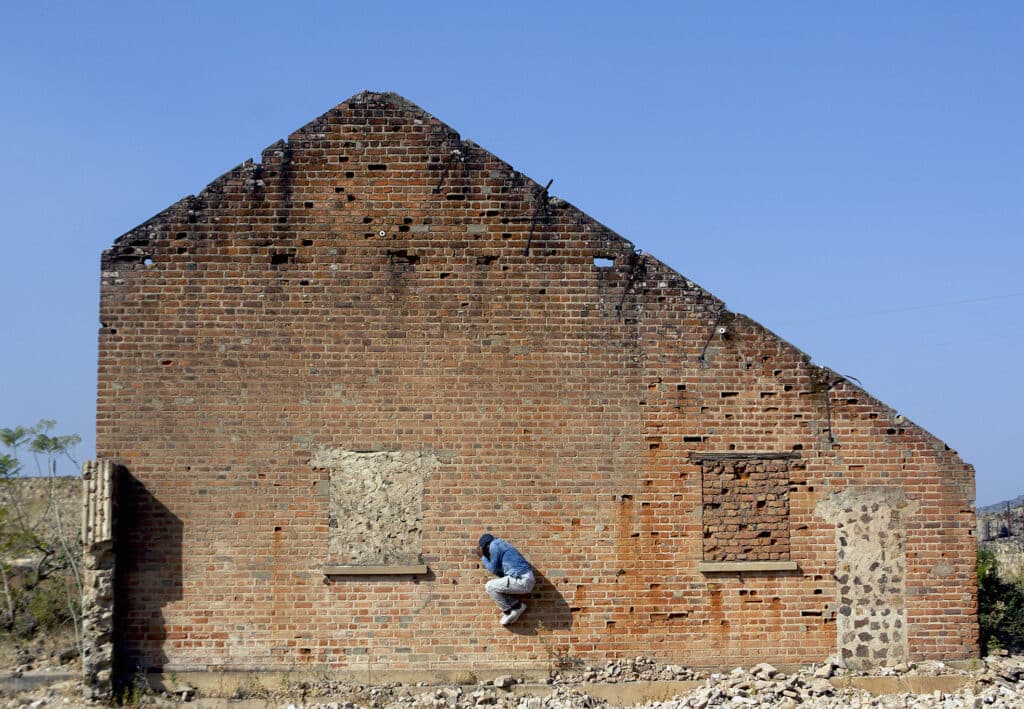
Partager des expériences personnelles par le biais d'images superposées
Je suis très captivé par la musique, et plus particulièrement par la musique d'ambiance. L'un de mes albums préférés est "Musique pour les aéroports"de Brian Eno. Lors de mon tout premier voyage en Europe en 2006, un conservateur m'a fait écouter cet album et m'a donné le CD. Je me souviens que la première fois que je l'ai entendu, j'ai pleuré. C'était incroyable que quelque chose puisse émouvoir quelqu'un au point de lui faire ressentir quelque chose. Et ce n'était pas bruyant. C'était tendre, mais aussi dur à sa manière. En approfondissant ce type de musique, j'ai commencé à découvrir des gens qui l'aimaient, Philip Glass et les autres, Steve Reich.
Grâce à cette exploration, j'ai commencé à m'intéresser davantage aux idées de néant et de tranquillité et à me débarrasser des notions antérieures de ce qu'est la photographie pour moi, en réfléchissant au médium lui-même et à la manière dont il pourrait être élastique. Au début, la performance m'a permis de jouer avec les compositions et la structure de mon travail. Plus tard, j'ai cherché d'autres moyens de développer ces idées et j'ai alors réalisé que je pouvais utiliser la répétition et le collage pour donner de la profondeur à mes idées. Je pense que la raison pour laquelle mon travail a tant évolué est que j'étais très attaché à la musique ambiante et aux sensations qu'elle me procurait. Je voulais commencer à faire des œuvres qui ressemblent à cela.
Je conçois désormais mon travail de manière sonore, comme si j'étais un compositeur. J'essaie d'établir des liens entre ce que je vois et ce que je ressens. Ce type d'images superposées me permet d'explorer des sujets importants, comme la violence exercée sur la terre par l'exploitation minière, par exemple, mais cela pourrait être exprimé par une photographie d'un paysage où se répètent des images déformées d'oiseaux et de terre les unes sur les autres. Ce qui m'intéresse le plus, c'est le poids de l'émotion que ce jeu d'images peut susciter. Je ne veux pas me laisser enfermer dans cette idée de littéralité. Je ne veux pas réduire l'œuvre parce qu'elle est bien plus qu'une simple représentation de l'histoire coloniale ou une documentation sur des sujets tels que l'extraction, l'exploitation, le corps ou la terre.
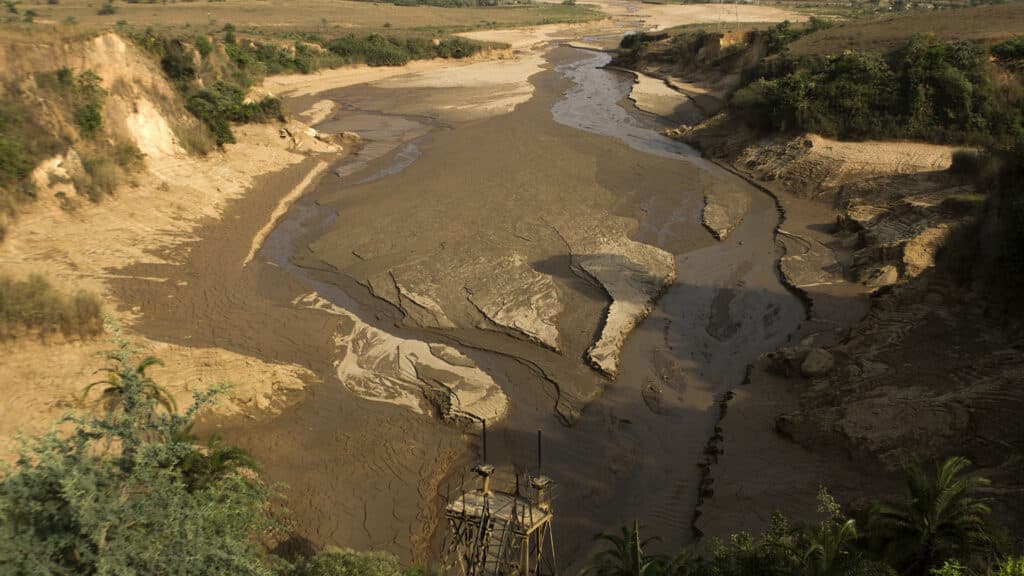
J'essaie de créer quelque chose de nuancé et de stratifié qui soit très interne. Je ne peux parler que de mon expérience, n'est-ce pas ? Je ne peux pas parler de l'expérience de tout le monde. Il s'agit donc de savoir ce que ces sujets, ce que l'état de notre monde signifient pour moi. Je vois le monde d'un point de vue particulier. L'immigration n'est pas la même chose pour moi que pour d'autres personnes. Ce sont ces petites expériences quotidiennes qui ajoutent des couches à notre expérience. Ce sont des structures qui sont mises en place pour humaniser certains types de personnes et pas d'autres. Tout à fait d'accord.
Ce sentiment se retrouve dans la façon dont j'essaie de créer les choses que je crée, qu'il s'agisse d'expériences personnelles ou de questions aussi vastes que le nationalisme. Mais il s'agit toujours de l'intérieur. Il y a quelque chose de beau là-dedans. Je pense que c'est aussi notre force en tant qu'êtres humains, n'est-ce pas ? Nous venons d'endroits différents, de races différentes, de milieux différents, d'histoires différentes. Mais il y a des similitudes dans nos expériences profondes et internes qui sont très similaires - que nous le voulions ou non, nous sommes tous connectés - et c'est tout simplement incroyable.
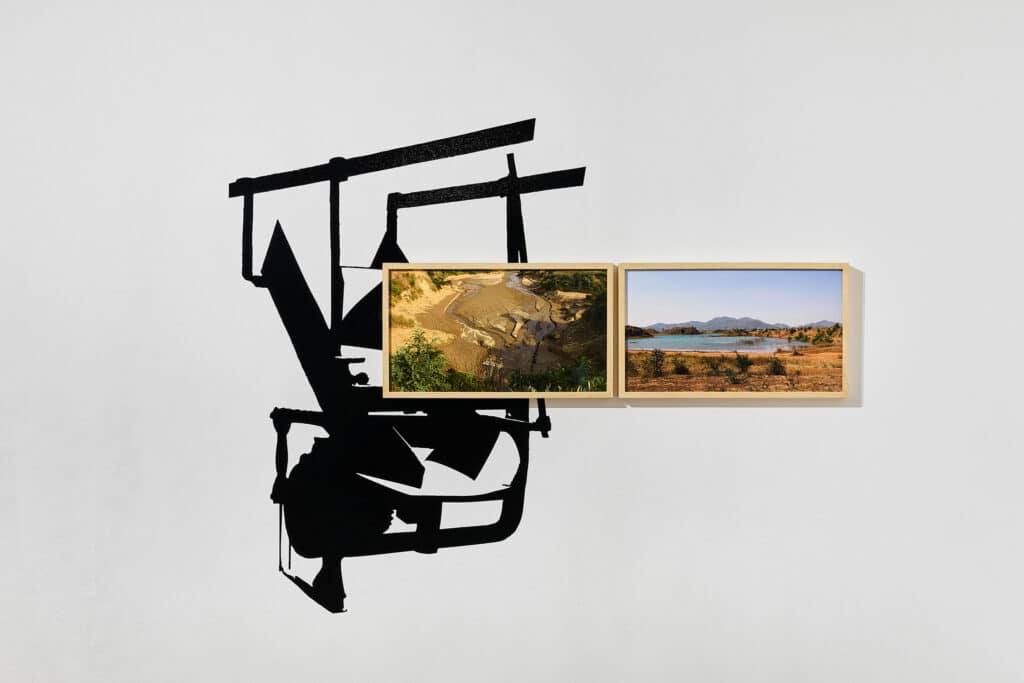
Sources d'inspiration : Mentors, livres et schémas
Les schémas sont également un outil que j'utilise pour parler des différentes fréquences dans mon travail. Je me souviens que je travaillais avec un célèbre photographe nigérian basé à Berlin, Akinbode Akinbiyi. C'est un vieux papa, vous savez, et il a été le mentor de beaucoup d'entre nous au fil des ans. Il m'a donné deux livres parce que je lui avais dit que je voulais commencer à travailler sur le sujet de l'exploitation minière au Nigeria.
L'un des livres était celui de Jane Mercy, de Johannesburg, qui réalise des sortes de dessins collés qui intègrent des photographies et des peintures. L'autre livre qu'il m'a donné s'intitulait "Sur les mines" par David Goldblatt. Les photographies de ce livre sont des compositions très frontales. Leur caractère direct est très pur et je les ai trouvées très inspirantes.
Chaque fois que je rendais visite à Akinbiyi, il m'emmenait dans ses librairies préférées à Berlin, où il est connu. C'est à l'occasion de l'une de ces visites que l'on m'a montré ce livre en deux volumes intitulé "Pratique métallurgique Rand." Ce livre a été publié en 1912. J'ai commencé à penser à cet énorme livre en deux volumes qui est essentiellement un diagramme méthodologique utilisé pour l'extraction des mines, à la fois à Johannesburg en Afrique du Sud et dans d'autres domaines similaires, c'est-à-dire les domaines qu'ils colonisaient, y compris le Nigéria, le Congo et d'autres endroits, comme le Ghana. C'était fascinant. Je ne connaissais pas l'étendue de cette histoire. Je ne savais pas non plus que ce type de livre existait. C'était très mathématique, très technique, très physique, mais c'était aussi très beau d'un point de vue esthétique. Sur cette base esthétique, je me suis dit : "C'est intéressant." Mais je ne savais pas quoi en faire ni comment l'aborder. J'ai eu ce livre pendant quatre ans avant de travailler sur les mines. Je pense que le moment où j'ai commencé à travailler sur les mines a été celui où j'ai commencé à photographier ces paysages.
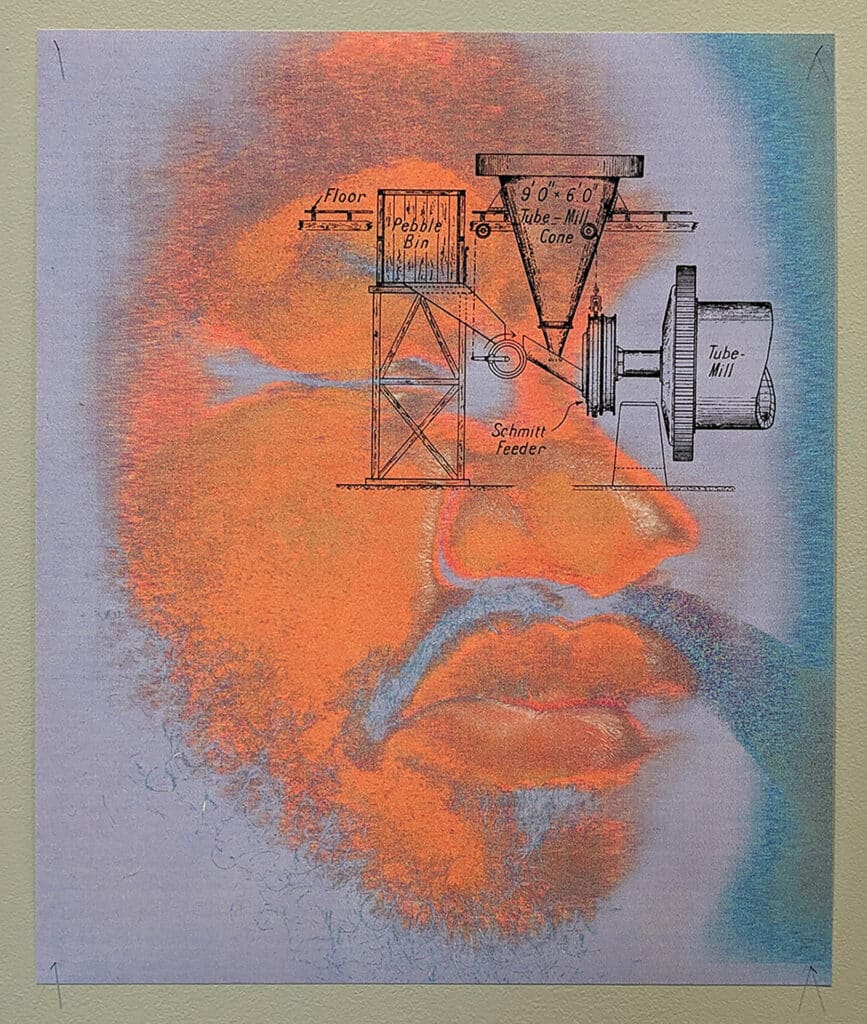
Dès que j'ai commencé à le faire, j'ai commencé à faire le lien entre les schémas et les paysages. J'ai alors compris que tous les schémas pouvaient aussi devenir une sorte d'animation. J'ai alors recommencé à voir les schémas comme des hiéroglyphes, comme un langage. Je me suis dit : "Bon, je commence à y voir plus clair."
Pour moi, ces schémas sont un langage ou une sorte de partition. Je les utilise donc et les intègre à mon imagerie de différentes manières. Parfois, je les utilise même (comme pour l'exposition à la Hunt Gallery), comme vinyle mural pour qu'ils puissent aussi être vus seuls. De nombreuses possibilités émergent lorsque l'on commence à voir comment on peut déplacer des objets et presque échantillonner des informations et des images comme si l'on était un DJ. Il s'agit d'une stratégie similaire à celle de la musique comme le hip-hop, qui consiste à prendre toutes ces couches à différents endroits pour créer un nouvel ensemble. C'est fascinant parce que cela crée de la profondeur, mais aussi un certain type d'abstraction. Toutes les couches de l'œuvre créent également leur propre signification dans l'œuvre. Elles ne peuvent plus être vues isolément - elles créent une expérience à facettes avec de la profondeur.
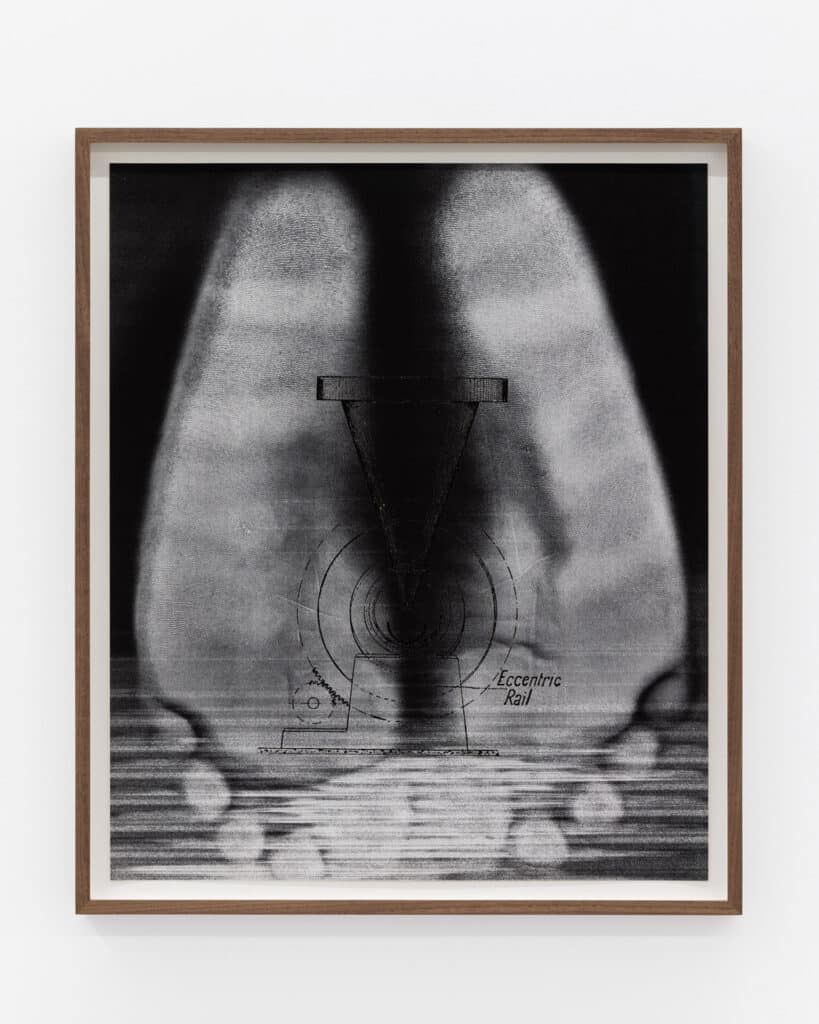
Capturer la magie
J'ai vécu une expérience que je n'oublierai jamais lorsque je photographiais des mines. J'avais passé des heures à photographier en plein soleil et je suis resté jusqu'à ce que le soleil se couche vers 18 h 30. J'ai grimpé une colline et, de loin, j'ai vu le petit bus traverser une colline. C'était le même genre de colline que celle sur laquelle je me trouvais. C'était un moment où les choses me semblaient très liées - la lumière, la répétition du paysage, et ces poteaux électriques et autres choses qui alimentaient les mines.
J'ai fini par photographier la scène sous différents angles. J'ai photographié le fait d'être sur cette colline, j'ai photographié les gens que j'ai rencontrés ce jour-là. Je ne les connaissais même pas, mais j'ai juste vu ce bus, sur cette vaste terre massive, une terre tranquille. Et puis vous voyez la poussière, c'était un moment tellement beau. C'est l'un de ces moments où la photographie est magique. Je savais que je photographiais quelque chose de vraiment spécial. Je le savais. Je ne le dis pas souvent, mais c'est vraiment l'une de mes images préférées. Et il ne s'agit pas de savoir si quelqu'un la collectionne ou non. C'est vraiment ce qu'elle représente pour moi personnellement. C'est vraiment un cadeau. Ce moment a été un cadeau pour lequel je suis toujours très reconnaissant. Je suis toujours reconnaissant à Dieu de m'avoir accordé ce moment - cette magie qui s'est produite.

Être ouvert ; la capacité de réimaginer
Être un artiste est un combat. Ce n'est pas facile. Parce qu'on cherche quelque chose. On est à la recherche de son vrai moi. Le résultat de tout cela est presque comme un document du temps, ce que nous créons. Mais nous sommes juste dans cette affaire d'accomplissement qui va aussi très loin. C'est un voyage. Et c'est quelque chose que je veux toujours que les gens comprennent : la création artistique n'est pas un modèle unique. Le parcours de chacun est complètement différent.
Je pense qu'il est également important que chacun soit ouvert à d'autres pratiques, à d'autres personnes, à l'amour. Lorsque nous réfléchissons aux systèmes de pouvoir, il est important de les réimaginer ou de les recontextualiser. Ce sont des mots que je préfère à "démanteler". Démanteler, c'est presque détruire quelque chose. On ne le détruit pas, mais on le perturbe. C'est comme un tremblement de terre. Vous le sentez, vous savez, vous pouvez le sentir. Vous avez peur. Tout d'un coup, vous êtes conscient. On se dit, mon Dieu, je pourrais perdre la vie ou quelque chose comme ça. Je ne veux pas susciter la peur dans ce que je crée. J'essaie de trouver différentes façons de réimaginer ces structures de pouvoir, ces structures de représentation, parce que c'est en fait là que se trouve l'agence ultime.
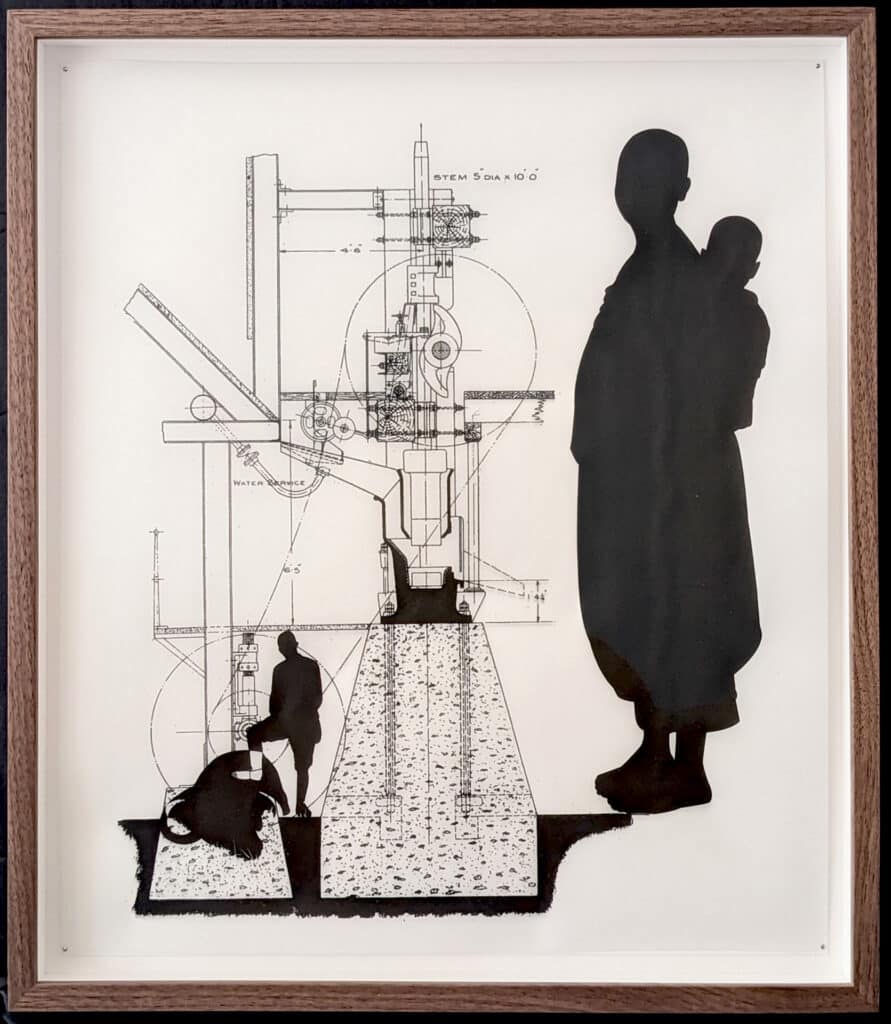
Accès et engagement auprès des institutions artistiques
Lorsque l'on expose dans des institutions, je pense qu'il est important d'avoir un dialogue. Il est important d'être ouvert, d'apprendre de ces institutions, n'est-ce pas ? De s'engager fortement avec ces institutions et, d'une certaine manière, de remettre gracieusement en question les systèmes, d'un point de vue esthétique, dans votre travail. Mais l'accès est très important pour traiter avec ces institutions. Lorsque vous obtenez l'accès, je pense qu'il est important de réaliser que c'est déjà un grand pas vers un discours critique. C'est quelque chose que j'apprécie. J'ai l'impression qu'il faut parfois arriver avec grâce et non pas avec un sentiment de droit. Nous devons faire preuve d'empathie pour être en mesure d'aborder ces objets ou ces archives sans les vilipender, mais en engageant un discours global sur le racisme, le racisme systémique ou le racisme institutionnel.
L'accès, comme je l'ai dit, est très important. Et cet accès, lorsqu'il est obtenu, crée une route pour la génération suivante. Il leur ouvre la voie. Nous devons comprendre qu'il s'agit également d'une question de pédagogie, et qu'il faut être ouvert pour pouvoir enseigner à ceux qui viendront plus tard. Je pense qu'il est important de faire preuve d'humilité.

Éducation et communauté
J'ai terminé ma maîtrise en beaux-arts à l'université de York il y a deux ans. Ces jours-là ont été très étranges, car dès que j'ai été admise au programme, le COVID a frappé. J'ai donc fait ma maîtrise pendant le COVID et j'ai obtenu mon diplôme. C'était terrible, mais nous avons fait en sorte que ça marche et je me suis fait de bons amis. Même avec toutes les restrictions, c'était une communauté formidable.
J'aime Toronto. J'aime la communauté artistique. L'ambiance artistique est vraiment - c'est un petit endroit. Il est donc très facile pour les gens de se connaître. Mais j'aime vraiment cet endroit. C'est calme. Je peux me concentrer sur mon travail. Je peux voyager, revenir. C'est un excellent point d'ancrage. En ce moment, je travaille sur une commande pour la Biennale de Toronto, présentée conjointement avec la Gallery TPW. C'est ce qui m'occupe le plus en ce moment. Je suis en train de finaliser la production de mon installation d'œuvres imprimées, de dessins et d'objets - intitulée Onoriode (Qui sait demain ?)-et il ouvrira ses portes le 21 septembre 2024.
Vous pouvez visionner une partie de notre conversation ici :
